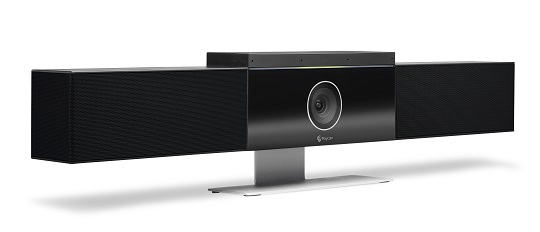Plantronics, one of the leading audio technology companies, has jumped into the crowded huddle room market with
today’s announcement of Polycom Studio.
With Polycom Studio, Plantronics said it aims to deliver best-in-class audio and video quality and make the product dead simple to deploy. The latter is meant to address one of the challenges of putting equipment into a huddle room -- that being the need to stitch together disparate equipment, such as cameras, speakers, displays, and other infrastructure.
Polycom Studio is a plug-and-play all-in-one device with integrated speakers and camera. The only attachment, other than for power, is a single USB cable that connects to a Windows PC or Mac. Once installed, “Polycom Studio” will show up in the microphone, camera, and speaker lists of a meetings application. The product works with all the mainstream video-as-a-service (VaaS), Web meeting, and team collaboration services, including Microsoft Teams and Skype for Business; Zoom; Cisco Webex Meetings; Google Meet; and Amazon Chime. Polycom Studio can either use the computer’s display or a monitor, TV, or other external device connected to the computer.
To prove how easy this new huddle room system is to install, Polycom’s market research manager, Katie Atwell, hand-delivered a device for me to set up. I initially pushed back on Polycom’s offer to send me a device because I had a busy schedule with many things to do before heading out to travel later that day. I didn’t want to waste hours getting the thing up and running, as I’ve experienced with other meeting room and huddle room systems -- no matter how easy to use the vendor states the product is, gotchas always come along. Plantronics assured me that wasn’t the case with Polycom Studio, so I gave it a go.
Here’s a summary of my experience:
- The product indeed is an all-in-one solution. The only items in the box (outside of manuals) were the Polycom Studio device itself, a power cord, and the USB cable.
- Polycom Studio is, in fact, dead simple to install. It took me all of five minutes to unbox the device and get it up and running -- and that included waiting for a meeting invite and connecting to a Skype for Business meeting with Chris Thorson, Polycom senior director of solutions marketing. Note that Polycom Studio is designed to sit on a table or desk, so I didn’t have to take the time to or worry about mounting it on the wall (although Polycom does offer a mounting bracket for those customers that prefer affixing the device to the wall). For test purposes, I have it sitting on my credenza.
- Audio quality was outstanding. Without the bar, I’m limited to connecting through the computer speakers and microphone or headset. This can be OK for a one-on-one call, but certainly isn’t optimal for huddle rooms where there are multiple people. As the product name suggests, the audio of this product was comparable to studio quality.
- Video quality was equally good. Polycom’s heritage is video, so I’d expect nothing less than best in class in this area. Studio is outfitted with 4K resolution, 5x electronic zoom, and an ultra-wide 120-degree field of view.
The product came loaded with many of features Polycom has developed over the past several years with the goal of taking the friction out of meetings. Polycom Studio includes automatic speaker tracking capabilities as well as the ability to reframe video when someone speaks. This means as a speaker moves around a room, the camera refocuses so remote participants don’t need to fiddle with their views. Also, Studio includes NoiseBlock technology; this feature automatically mutes background noises, such as the dreaded loud typing. Another cool feature is Acoustic Fence, which automatically eliminates any noise from outside the “fence.” This enables a Studio to be deployed not just in huddle rooms but in open areas where people might want to meet and collaborate ad hoc. A companion application lets users do things like change framing preferences and turn NoiseBlock on and off.
Polycom Studio wireless connects to the enterprise network, making it manageable via the cloud-based management service, Polycom Device Management Service for Enterprise. While I haven’t had a chance to test out the management tool myself, I have talked to a few Polycom customers that say the portal is intuitive and helps with tasks such as staging devices, updating software, and changing configurations.
If I were to make a recommendation to Plantronics, it would be to update the USB adapter for Polycom Studio. At one time, USB ports were ubiquitous, but not now. I have a new MacBook with USB-C only, and it would have saved me a step, albeit a small one, when connecting the device. I happened to have an adapter handy, but I could see the case where a customer doesn’t and then needs to order one or run out and buy one, delaying the implementation. Plantronics could either include an adapter with Polycom Studio or ask during the ordering process what the preferred connector is and then ship one with it.
Huddle rooms have exploded over the past few years, but few are outfitted with the right technology. In its press release, Plantronics cited a Research and Markets data point that found that only 2% of the 32 million huddle rooms worldwide contain video equipment. In the digital era, competitive advantage is based on making the best decision, involving the right people, in as short a time as possible -- and that’s best done over video. This need for more efficient collaboration should create a rising tide on which Plantronics and other vendors should be able to capitalize.
Polycom Studio will have a list price of $949, and be available later this quarter in North America, Europe, and select additional countries.









